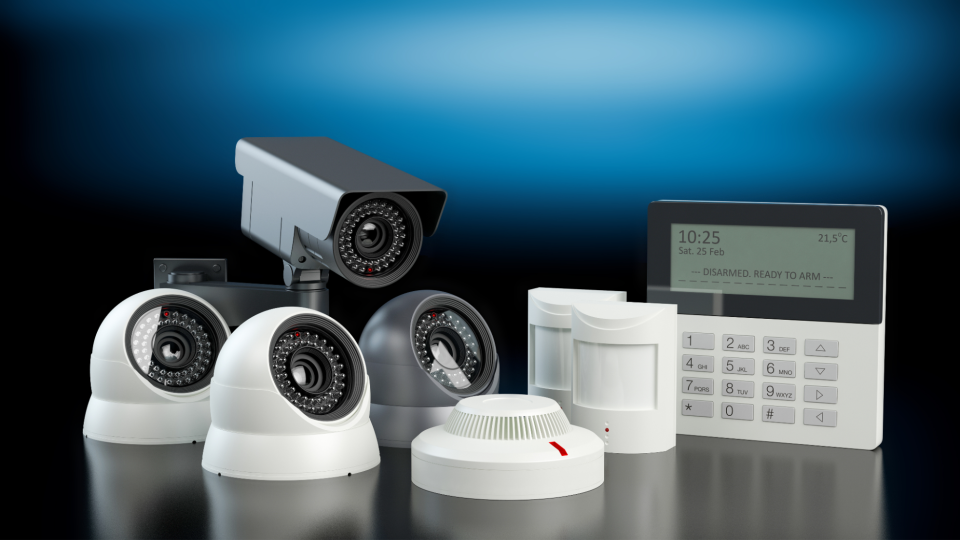How do home security systems work? Learn the basics
Content is created by CNN Underscored’s team of editors who work independently from the CNN newsroom. When you buy through links on our site, CNN and its syndication partners may earn a commission. Learn more

Home security technology has come a long way from the old wired systems most of us picture when we think of burglar alarms. Modern systems are easier to install and integrate with home automation features like smart lighting and thermostats. With all the advancements, you may wonder how home security systems work.
In this guide, we’ll explore how home security systems detect intruders through devices like cameras, control panels and motion sensors.
What is a home security system?
A home security system is a web of connected appliances that protect your home by monitoring for burglars, flames, toxic fumes and other potential hazards. Its main components include alarms, a control panel and sensors.
Home security systems range from DIY kits with self-monitoring to professionally installed and monitored setups. Homeowners and renters invest in home security systems for property protection, peace of mind and smart-home capabilities, such as remotely controlling locks, lights and thermostats. Home security system prices vary based on equipment and monitoring plans.
How do home security systems work?
Home security systems use a network of cameras, sensors and a control panel to monitor a home.
Cameras provide visual verification of activity happening inside or around the home.
Motion sensors inside rooms pick up movement and occupancy (and trigger alarms when they detect a potential threat).
Sensors installed on entry points (e.g., doors and windows) detect intrusions.
Alarm systems respond to sensor triggers based on homeowners’ settings and whether they are professionally monitored or self-monitored.
Professionally monitored: Alerts a monitoring center that dispatches emergency responders if necessary
Self-monitored: Relies on homeowners to receive notifications and act on them as needed
What does a typical home security system include?
The main components of a typical home security system are:
Cameras: Provide visual verification on video (indoor, outdoor and at the doorbell)
Contact sensors: Detect open entry points like doors and windows
Control panel: Coordinates sensors and devices (the brain of the system)
Environmental sensors: Detect fires, water leaks and carbon monoxide
Glass break sensors: Listen for the sound frequency of broken glass
Key fob: Arms/disarms the system or panic alarm (handheld remote)
Motion sensors: Detect movement and occupancy inside rooms
Siren: Blares as a deterrent when sensors detect a threat, typically ranging from 90 to 120 decibels

How do home security systems detect and respond to intruders?
Home security systems use sensors and cameras to detect intruders. When triggered, systems respond based on monitoring type — professional monitoring or self-monitoring. Let’s break down how they differ:
Professionally monitored systems
Professionally monitored systems involve a monitoring company. When a sensor triggers, it alerts the company’s 24/7 monitoring center. An agent verifies the alarm isn’t false by viewing the camera footage. They may then call the home and/or notify the police to dispatch immediately.
Homeowners pay a monthly fee for the monitoring company to handle all verification and dispatch. A professionally monitored system could be a worthwhile investment if:
You aren’t tech-savvy and prefer a done-for-you approach to emergency response.
You aren’t home often and want added security and peace of mind.
You don’t mind a monthly recurring expense.
Pros and cons of professional home security monitoring
Pros
24/7 monitoring and dispatch
Comprehensive protection
Convenient peace of mind
Many come with battery backups
Cons
Can be costly
May require a lengthy contract
Middleman involved
Possible false alarm penalties
Self-monitored systems
Unlike professionally monitored systems, self-monitored systems rely on homeowners’ vigilance. When a sensor triggers, homeowners receive mobile alerts. They can view live video feeds and notify the police if needed.
If you go this route, you must be willing and able to respond to all system notifications. The police won’t check on you unless you request it.
You may prefer this solution if:
You spend a lot of time at home and like having complete control.
You’re tech-savvy and can call the police quickly if needed.
You need home protection on a budget.
Pros and cons of self-monitored home security systems
Pros
Easy and flexible configuration
Full control (no intermediary)
No monthly fees
Cons
Limited protection
Most require Wi-Fi to work (you won’t receive emergency notifications on your phone if you’re in a no-signal zone)
No 24/7 monitoring and dispatch
How do cellular home security systems work?
Cellular security systems use wireless cellular signals to work without a landline phone connection. Cellular systems work similarly to landline systems as far as setup, use, cameras, sensors and control panel.
However, they use cellular instead of phone lines for communication. The control panel and sensors have built-in cellular radios. When something triggers a sensor, it sends an alert through the cellular network to the monitoring center.
You may consider a cellular home security system if:
Your home doesn’t have a landline.
You live in a rural area with spotty Wi-Fi.
You need secure and reliable home protection.
Exploring Wi-Fi capabilities in home security systems
Many home security systems today also use Wi-Fi. This allows wireless operation without landlines or cellular. The control panel and sensors connect to the home’s Wi-Fi network.
When triggered, the sensors send real-time alerts to the control panel and homeowner’s smartphone via the Wi-Fi network. This also enables remote system access and control through mobile apps.
A benefit of Wi-Fi systems is avoiding monthly landline or cellular fees. But on the flip side, having spotty Wi-Fi could pose a security risk. If the internet goes down, so does the security system’s communication.
Generally, Wi-Fi security systems provide affordable wireless operation. However, cellular systems offer more reliable communication through cellular networks if Wi-Fi is unstable.
How remote viewing works in home security systems
Remote viewing and control through mobile apps allow residents to check cameras, adjust smart thermostats, control devices and arm/disarm the system from anywhere.
The home security system’s app connects to the home’s Wi-Fi network or cellular system.
From there, you can:
Access footage stored on the system’s cloud storage or cloud servers
Check alerts and live video camera streams in the app
Verify activity and take action at any time — even when you’re not at home
Benefits of cloud storage in home security systems
Cloud storage is becoming popular for home security systems. With it, you can store video footage and alerts remotely.
Key benefits include:
Access recordings anywhere with an internet connection
Affordable monthly plans for most providers
Easily review and share clips stored in the cloud
Extra protection if local digital video recorders are damaged or stolen
Home security systems for homeowners
As a homeowner, finding the right balance of convenience, smart monitoring and potential to add capabilities to your home security system in the future is crucial. The system should suit both property protection needs and your household’s lifestyle.
DIY vs. professionally-installed system
Owning a home allows you to choose between a DIY or professionally installed system, depending on your preferences and skills. The DIY approach is particularly attractive to homeowners comfortable with technology who prefer a hands-on setup experience.
Chantel Cruikshank, a host for the home-sharing company Airbnb, said that a DIY system has sufficed for her current home. “We’re in a safe rural-residential area, and there aren’t interior break-ins. We have outdoor cameras set up to see people coming and going and to ensure guest safety.”
On the other hand, a professionally installed system is ideal if you aren’t tech-savvy and would rather trust an expert to secure the equipment properly. In this scenario, a home security professional handles every aspect of the installation within your home. While this convenience comes at a cost, it eliminates the hassles and uncertainties involved in setting it up solo.
Smart-home integration capabilities
It’s increasingly important for home security systems to integrate seamlessly with major smart-home platforms. Tyler Guffey, a network engineer and the CEO of Sycamore Net, a leading source for software information, emphasized integration.
“Integration allows homeowners to consolidate controls and routines, creating a more cohesive smart-home experience … It’s an essential consideration for those already invested in a particular ecosystem or those looking to build out their smart home,” Guffey said.
By investing in a system that integrates with third-party smart devices like Amazon Alexa, Apple HomeKit and Google Assistant, you can control your security systems using voice commands and other smart features to help you feel safer and in more control:
Adjust your thermostat from anywhere
Close your garage door remotely
Lock your gates or doors automatically at a specific time
Turn on lights when there’s movement (and off when there’s not)
Other features worth considering
Besides compatibility with smart-home ecosystems, Guffey suggests other home security system features you may find helpful as a homeowner:
24/7 monitoring if you want a dedicated team looking out for potential security breaches
Battery backup to ensure the system remains active during power outages
Indoor and outdoor cameras with a clear resolution, night vision and motion detection
Modular equipment that allows expanding coverage as needed
Remote access that lets you control and monitor the system from a smartphone or computer
Smart-lock integration to control door locks remotely
Subscription plans that offer monitoring options to switch on/off professional monitoring
Two-way talk to communicate through the security system (often seen in doorbell cameras)
Home security systems for renters
“The best home security options for renters are wireless. Though the wired ones tend to be more reliable, they also require installation,” according to Brittany Mendez, the CMO at vacation rental company Florida Panhandle.
“Landlords may not like this or approve it. But with wireless devices, you can put them up easily without disrupting anything,” she explained. Best of all, “if you move to a new place, you can take the system with you.”
Shop for wireless solutions that don’t require drilling holes. For example, Ring offers DIY options with peel-and-stick sensors that don’t damage walls or need wiring, allowing you to stay safe without losing your security deposit at the end of your lease.
While DIY systems may not offer all the perks of a professionally installed system, they can provide similar core intrusion protection. Features like alarms, entry sensors, motion detectors and mobile notifications allow you to secure your space. You can always look into upgrading monitoring for added protection.
Bottom line
Securing your home is easier than ever, thanks to evolving technology. Modern systems use wireless equipment, cellular and Wi-Fi connectivity and smart monitoring.
Whether you’re a homeowner or a renter, evaluate your space, needs and lifestyle when choosing a home security provider. Look for versatility, scalability and automation integrations in a system rated for ease of use. Finally, consider both DIY and professionally installed and monitored systems to find the right balance of convenience and protection.
Frequently asked questions (FAQs)
Note: The prices above reflect the retailers' listed price at the time of publication.
For more CNN news and newsletters create an account at CNN.com

